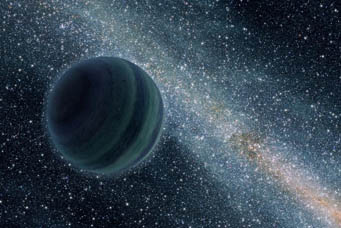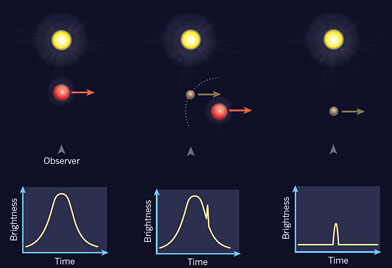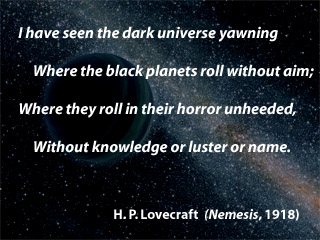Ask an astronomer how many stars populate the Milky Way, and the usual answer will be 200 to 400 billion. It's not that all those suns have actually been counted; instead, it's a statistical guesstimate based on the census in our immediate interstellar surroundings.

An artist's portrayal of a rogue planet drifting alone through interstellar space, lit only by starlight.
NASA
But a new study, published in today's issue of Nature, suggests that a complete census of "big bodies" drifting loose in our galaxy might actually total nearly one trillion — because Jupiter-mass "planets" in interstellar space might well outnumber the stars themselves.
The evidence for this sudden glut of planet-mass objects comes from a dedicated search by two teams of observers: the Microlensing Observations in Astrophysics (MOA) Collaboration and the Optical Gravitational Lensing Experiment (OGLE) Collaboration.
In 2006-07, the MOA and OGLE teams used telescopes in New Zealand and Chile, respectively, to monitor the brightnesses of 50 million stars located in the huge stellar bulge surrounding the Milky Way's center. Led by Takahiro Sumi (Osaka University), observers used these facilities to record the brightness of each star at least once per hour. After boiling down all that data, the teams found that 474 stars had briefly surged in brightness in a way that indicated gravitational lensing of their light by unseen foreground objects passing nearly front of them. During these incidental syzygies, the gravity of the foreground object bends and concentrates the light from the background star — an event known as microlensing.

Left: The gravity of a foreground star (orange) can act like a lens to focus and amplify the light from a more distant star (yellow), causing a brief surge in brightness that's detectable from Earth (bottom). Center: If the foreground star has a massive planet, a double-peaked light curve results. Right: A solitary planet, either far from its host star or floating freely, creates a smaller, much briefer lensing event.
Nature
Microlensing searches aren't new: they've long been used to search for massive dim or dark objects in the galaxy. But the MOA and OGLE teams found that 10 of these little surges lasted less than two days — too short to be caused by stars but just right for Jupiter-mass objects. Based on these statistics, the teams estimate that big planets must be far more common than believed and in fact must outnumber all the Milky Way's normal stars by about two to one.
Surprisingly, during these 10 brief events there were no corresponding lensing surges to betray the presence of nearby stars. So the observers conclude that these "Jupiters" must either be at least 10 astronomical units from their host stars (at least Saturn's distance from the Sun), or they are orphans drifting freely across interstellar space. They're more likely to be free-floaters, because previous direct-imaging searches found that giant planets rarely exist in very wide orbits.
"The implications of this discovery are profound," notes lensing specialist Joachim Wambsganss (Heidelberg University) in an accompanying Nature perspective.

Kelly Beatty
Theorists are chuckling, "We told you so!" They've argued for years that the galaxy should teem with unbound planets. Some have proposed that objects with masses almost as low as Jupiter's form the way normal stars do, directly from collapsing clouds of gas and dust. Think of these as undersized brown dwarfs. Others point out that the chaos that seems to prevail in many just-formed solar systems must cause many close encounters among planets that yield "winners" (those that remain in orbit) and "losers" (those that get flung out of the system entirely).
During the 1990s, while studying gravitational lensing of the distant quasar Q0957+561, Rudolf Schild (Harvard-Smithsonian Center for Astrophysics) inadvertently picked up brief brightness blips. Wesley Colley (University of Virginia) and Schild eventually concluded that these little flashes resulted from lensing by free-floating substellar objects (ranging down to an Earth's mass) in the intervening galaxy, roughly a billion miles away.
Later, Schild and others suggested that Mikly Way and other galaxies contains enough "micro brown dwarfs," nearly a billion trillion in each, to provide the long-sought missing mass (dark matter). But others counter that there's no way these unseen bodies can exist in such vast numbers.
In any case, the MOA-OGLE statistics imply that most of the loose planet-mass objects aren't low-mass stellar wannabes. Instead, the researchers believe they're finding bodies that have been ejected from unstable planetary families — and, by extension, that planetary systems should be the norm, not the exception, for the Milky Way's hundreds of billions of stars.
This also implies that early chaos in planetary systems is common. Exoplanet researchers had already concluded that this is the case from the large number of explanets that have been left in highly eccentric orbits, which they could not have formed with.
The Jet Propulsion Laboratory's PlanetQuest website has more details and a nice animation that shows how microlensing works.
 11
11









Comments
Robby Cicco
May 20, 2011 at 9:51 am
Could this be the unaccounted-for mass that has been dubbed "Dark matter"?
You must be logged in to post a comment.
Mark Looper
May 20, 2011 at 11:14 am
No -- these wandering planets would be made up of ordinary matter (protons, neutrons, electrons), and calculations of nucleosynthesis in the Big Bang and several other lines of evidence argue that most of the dark matter is "non-baryonic," i.e., something besides ordinary matter (protons and neutrons, which make up most of the mass of ordinary matter, are "baryons").
A couple of years ago S&T printed a great article that summarized those "lines of evidence," and demonstrated why it makes sense to hypothesize such weird stuff as non-baryonic dark matter and the even weirder "dark energy," in the absence of direct detections (that's the "dark" part). Is that article online somewhere so that I could point (non-subscriber) friends to its URL?
You must be logged in to post a comment.
Earl Butterwick
May 20, 2011 at 11:17 am
Also, dark matter exist in the intergalatic void of space. Planets do not.
You must be logged in to post a comment.
Allan Holmgren
May 20, 2011 at 6:15 pm
While I would assume that there would be many free floaters due to planetary billiards in steller disks, I don't see why a planet at 10 AU's should be considered a free floater. Our own solar system seems to manage stable orbits for Uranus and Neptune and so a lot of these planets could still be bound to their host stars. What I find more interesting is the possibillity that there may be even more of these free floaters in the Earth or Mars mass range and I would predict that they will eventually be discovered as out technology immproves. I think the more profound conclusion from these observations is this must change our assessment of the mass of the other galaxies out there. This must make a new variable in our assumption of dark matter to visible matter in these galaxies.
You must be logged in to post a comment.
Joel Marks
May 20, 2011 at 7:55 pm
I remember being amazed by the scientific prescience of Philip Wylie’s sci-fi classic, When Worlds Collide. Now more than ever! I guess it's not "just" asteroids and comets to worry about.
You must be logged in to post a comment.
Rod
May 20, 2011 at 8:40 pm
I am not sure what to make of this report and others I have read on this subject. The exoplanet website shows 551 now as of 05/17/11. None of these are nice habitable earth like orbits or bodies from the data and stats. Now it looks like planetary formation ejects numerous planets into the void. Just how did our Earth escape such an outcome like wandering in the void or death by inward wandering jupiters to become hot jupiters or perhaps falling into the Sun? My answer - read Genesis 1:1 and Isaiah 45:18.
You must be logged in to post a comment.
Edward Schaefer
May 20, 2011 at 9:49 pm
I find the statement that "previous direct-imaging searches found that giant planets rarely exist in very wide orbits" to be very odd. Only in the last few years has it even become possible to perceive planets through direct imaging, and I believe that those which have been perceived so far are all bigger than Jupiter. I for one suspect that earlier surveys have failed to find planets because they were not sensitive enough to see a large planet distant from even relatively close stars. So my guess is that as time goes on, we will find that many if not most of the 10 apparently free-floating planets were most likely bound to a star.
Even so, it is still a neat result that those planets (be they bound or unbound) are out there.
You must be logged in to post a comment.
Michael C. Emmert
May 20, 2011 at 10:46 pm
If you look at infrared images of close stars, you can see their Kuiper belts because the dust has more surface area than the star or any planet. About half are flat like pancakes, as should happen to a collapsing gas disc. But about half are shaped like doughnuts or bagels.
I think this reveals a new class of objects. These formed at about 100 - 200 A.U. and if they get eccentric from encounters in the birth cloud or later then they might disturb the main stars' Kuiper belt.
I hope sometime this month WISE finds such an object for our own Sun. It might be the cause of periodic mass extinctions as seen in the geological record. I suspect that some of the OGLE and MOA objects fall into this class.
As yet, only the techniques described above can detect these things. According to J. Davy Kirkpatrick of the WISE team they should be magenta colored from abosorption of green light by sodium and potassium ions, so I propose the name "Magenta" for this class of objects.
You must be logged in to post a comment.
Rod
May 21, 2011 at 9:04 am
There are 6 documented exoplanets that have been imaged directly in the exoplanet URL DB. Their semi-major axis range from 12-330 AU and masses 3-10 Jupiters. We have beta pic b, Fomalhaut b, HR 8799 b, HR 8799 c, HR 8799 d, and 1RXS1609 b. Perhaps it is time for S&T to keep a DB on all the exoplanets. I keep mine in MS Access 2010 and SQL as well as Sun Open Office 3.3.
You must be logged in to post a comment.
Don Clouse
May 24, 2011 at 4:50 pm
Free floating planets don't seem to be much of a surprise as pointed out in the article due to ejection during planetary system formation and probably independent formation as well. Also, it a "continuity" thing. There are very few of the true monsters, O & B type stars. But as you move down the sequence the stars get rapdily more numerous down to class M. It would seem reasonable to assume that the progression proceeds through T and L class to brown dwarfs to giant Jupiters all the way to as small as you care to go - with each "class" becoming geometrically more numerous. I would also see no reason to presume that there are no free floating planets in intergalactic space. It's probably littered with them (and T dwarfs and M dwarfs and everything else). Afterall, think of all the pictures you've seen of galactic interactions and all those long, diffuse tidal tails. Galactic interactions (and the resulting scattering) has been going on for a very long time.
You must be logged in to post a comment.
Ed Tarver
May 25, 2011 at 9:24 am
This article plus other recent ones concerning gross underestimation of the number of stars leads me to the question of "How much of this newly discovered mass does it take before we start accounting for the dark matter in the universe?"
You must be logged in to post a comment.
You must be logged in to post a comment.